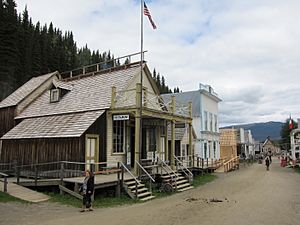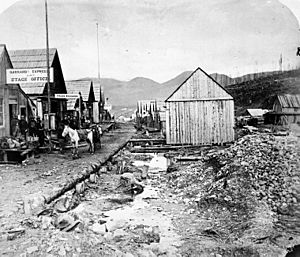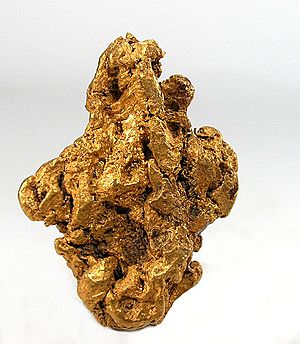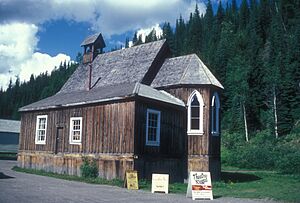Barkerville facts for kids
Quick facts for kids
Barkerville
|
|
|---|---|
|
Historic site
|
|

Barkerville's main street, 2012
|
|
| Country | Canada |
| Province | British Columbia |
| District | Cariboo Regional District |
| Founded | 1862 |
| Historical town | 1958 |
| Named for | William Barker |
| Elevation | 1,230 m (4,040 ft) |
| Population | |
| • 1863 | ~10,000 (Peak) |
| Area codes | 250, 236, 778 |
| Highways | |
| Website | www.barkerville.ca |
| Designated: | 1924 |
Barkerville was a very important town during the Cariboo Gold Rush in British Columbia, Canada. Today, it's a special historic town that people can visit. It sits on the side of the Cariboo Mountains, about 80 kilometers (50 miles) east of Quesnel. Highway 26 runs right through Barkerville. This highway follows the old Cariboo Wagon Road, which was the main way to get to the town long ago.
Contents
The Story of Barkerville
How Barkerville Started
Barkerville is found on the western side of the Cariboo Mountains in British Columbia. It got its name from Billy Barker. He was from England and was one of the first people to find a lot of gold here in 1862. His gold claim was the richest and most famous.
Barkerville grew incredibly fast, almost overnight. News of Billy Barker's gold discovery spread quickly, and people rushed to the area. His claim eventually produced about 1,065 kilograms (2,350 pounds) of gold!
Before the Cariboo Wagon Road was built, people had to carry their own supplies to Barkerville. They would carry them on their backs or use pack trains (animals carrying goods). Because supplies were hard to get, everyday items were very expensive. Prices only dropped after the Cariboo Road was finished. Then, large wagons could bring in many goods. People even boasted they could transport delicate champagne glasses without breaking them, for a price! More women also came to Barkerville after the road was completed.
Cattle were brought north from the Okanagan valley to provide meat for the miners and other residents.
A Growing Gold Rush Town
At first, Barkerville was just a few buildings put up by Billy Barker and his fellow gold seekers. But the town quickly grew, filling with homes, water wheels, and flumes (channels for water). By 1863, about 10,000 people lived there.
Even though many people only stayed for a short time, Barkerville became a real community. It had several general stores, places to stay, and a drugstore that also sold newspapers. There was a barbershop, a restaurant called the "Wake-Up Jake Restaurant and Coffee Salon," and even a theatre called the Theatre Royal. A group called the Cariboo Literary Society also met there. In 1867, the Hudson's Bay Company (HBC) opened a store, which became their main office for the Cariboo area.
Horse racing and boxing matches were popular ways to have fun. For those who were more serious, church services were very well attended. The general stores made the most money. Since they were the only place to buy food, owners could charge high prices. During the busiest time of the gold rush, flour cost as much as $1.25 per pound. Beans, meat, and dried fruit were a dollar a pound. But when the gold rush slowed down, many stores went out of business.
People of Chinese descent were a very important part of Barkerville for almost a hundred years. They started many businesses, like the Kwong Lee Company. This general store sold groceries, clothes, tools, and hardware. The Barkerville store was one of the most impressive in town. The Chinese community also built cabins for miners, who often shared them to save money. They also had a place called Tai Ping, which was like a nursing home. Chinese groups helped their community and solved problems without needing the regular courts.
Barkerville's Decline and Rebirth
On September 16, 1868, a big fire destroyed Barkerville. The wooden buildings burned very quickly. But people started rebuilding right away, and they worked fast! Within six weeks, ninety new buildings were up. The wooden sidewalks were improved, and the main street was made wider and straighter. By 1880, there were enough children for the Barkerville School, which had thirteen students and one chalkboard.
However, Barkerville's population started to shrink by the late 1800s. Eventually, only a few people lived there. The Hudson's Bay Company store closed in 1884. The town saw a small boost in the 1930s during the Great Depression. Many people were out of work, and the price of gold went up. But as the depression ended, Barkerville became a very small village again.
Preserving History
In 1959, the government of British Columbia created Barkerville Historic Park. This protected the area and its history. Over the years, the park grew in size.
In 2006, the park became Barkerville Historic Town and Park. This change helped make sure the town's history would be preserved for everyone to enjoy.
In 2008, Barkerville's Chee Kung Tong Building was named a National Historic Site of Canada. This two-story building was finished in 1877. It was used by the Chee Kung Tong group, which helped Chinese immigrants. It shows how Chinese workers and business owners built communities in new settlements across Canada.
Barkerville Historic Town and Park
Today, Barkerville Historic Town and Park offers camping at three sites: Government Hill, Lowhee, and Forest Rose. These sites are all managed by the park.
Bringing Barkerville back to life was a long process. In the 1940s, some buildings were torn down because they were fire risks. People also took things from the old, empty town. But a group called the Barkerville Historic and Development Company worked to fix up the town as a tourist spot. It took several years to make real progress. By 1958, Barkerville Historic Provincial Park was officially created. The town was restored, partly because the provincial government chose it as a big project for British Columbia's 100th birthday. The restoration aimed to bring Barkerville back to how it looked between 1869 and 1885.
Parts of the western movie Harry Tracy, Desperado were filmed here in 1980. The Punjabi film, Chhalla Mud Ke Nahi Aaya, was also shot here in 2022.
Barkerville's Climate
Barkerville has a subarctic climate. This means it has long, cold, and snowy winters. Its summers are short and cool because of its high elevation and northern location. The growing season for plants is only about 66 days long.
Notable People
- Bert Sincock – A Major League Baseball pitcher
See also
- British Columbia gold rushes
- Wells, British Columbia
- Cariboo Road
- Old Cariboo Road
- List of filming locations in the British Columbia Interior





